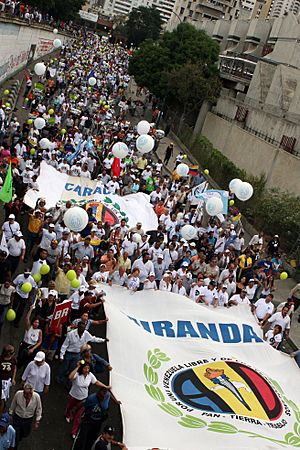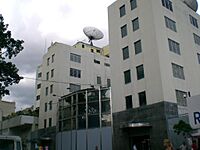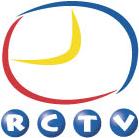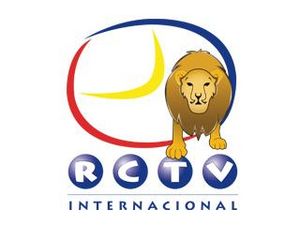RCTV facts for kids
 |
|
| Country | Venezuela |
|---|---|
| Headquarters | Caracas, Distrito Capital, Venezuela |
| Programming | |
| Language(s) | Spanish |
| Ownership | |
| Owner | Radio Caracas Televisión RCTV, C.A. (Empresas 1BC) |
| Key people | Marcel Granier Eladio Lárez (Pres., RCTV) |
| History | |
| Launched | 15 November 1953 (as a terrestrial network) 16 July 2007 (as a subscription network) 5 July 2020 (as an over-the-top streaming service) |
| Closed | 27 May 2007 (as a terrestrial network) 24 January 2010 (as a subscription network) |
| Former names | Radio Caracas Televisión (RCTV) (15 November 1953–27 May 2007) |
Radio Caracas Televisión (RCTV) was a famous Venezuelan free-to-air television network. It was based in Caracas. RCTV was owned by Empresas 1BC. William H. Phelps, Jr. started the network on 15 November 1953. Its radio partner was Radio Caracas Radio.
On 27 May 2007, the Venezuelan government decided not to renew RCTV's broadcasting license. This meant the channel had to stop broadcasting on regular TV. The government accused RCTV of being involved in a coup attempt in 2002. RCTV then started broadcasting through pay television as RCTV Internacional. In 2010, RCTV faced more issues and was temporarily closed again.
In 2015, the Inter-American Court of Human Rights ruled that the government's decision was wrong. They said it limited freedom of speech. The court asked Venezuela to give RCTV its license back. However, the Venezuelan government has not followed this ruling.
Contents
The Story of RCTV
How RCTV Started (1953-1960)
Radio Caracas Televisión, C.A. was created on 18 August 1953. It was part of a company called Coraven. Their goal was to start a TV network. In September, RCTV began testing its broadcasts. On 15 November 1953, the network officially started at 7:30 PM. RCTV was the third TV network in Venezuela. It was the second private, commercial network.
During its testing phase, RCTV broadcast a baseball game. This was the first game of the XIV World Cup of Baseball. It was between Cuba and Venezuela.
The official opening of RCTV happened at its studios in Caracas. Important people like the Minister of Communications were there. William H. Phelps, Jr., the company's founder, led the event.
The first show on RCTV was a music program called Fiesta. After that, they aired other shows like El Farol. The first voice that identified the network was Héctor Myerston.
The next day, RCTV began its regular programs. These included 'El Observador Creole', which was Venezuela's first regular news show. It was presented by Francisco Amado Pernía.
In 1954, RCTV started its first telenovela called Camay. Telenovelas became a very important part of RCTV's shows. In the 1950s, these shows were short, about 15 minutes long, and shown live.
By December 1954, RCTV was broadcasting on multiple channels. In 1955, RCTV started broadcasting to other parts of Venezuela. They installed antennas in different regions. This helped their signal reach many cities like Valencia and Maracay.
Also in 1955, the morning show Lo de Hoy became very popular. It was hosted by Renny Ottolina. This show was like the American Today Show. It was so popular that it was extended to two hours.
By 1957, RCTV had expanded its coverage. Its signal reached almost all of Venezuela.
In 1958, after a dictator left power, RCTV started La Voz de la Revolución. This was the first political talk show in Venezuela.
In 1959, a comedy series called La Gran Cruzada del Buen Humor was created. It later became known as Radio Rochela. In 2001, Radio Rochela made the Guinness World Records. It was on the air for over five decades without stopping.
Growing the Network (1960-1970)
In the 1960s, the American TV network CBS bought a part of RCTV.
In 1961, RCTV started experimenting with stereo sound. They also began using videotape systems. This allowed them to record shows instead of always broadcasting live.
A big fire affected RCTV's facilities in 1961. But the network managed to continue broadcasting with emergency programs.
In 1963, RCTV was chosen to broadcast the opening of the General Rafael Urdaneta Bridge. This was a big event. RCTV used microwave transmitters for the first time.
Between 1963 and 1969, RCTV aired a special TV movie. It was called El Ocaso de un Sol. This movie showed the death of Simón Bolívar. It was one of the first RCTV shows recorded on videotape.
By 1964, telenovelas changed. They became longer, lasting 30 to 60 minutes. They were also recorded, not live.
In 1965, RCTV expanded its signal to the Andean region of Venezuela.
By 1967, there were seven TV networks in Venezuela. But by the early 1970s, this number was reduced to four.
In 1968, RCTV launched Sabado Espectacular. This was a variety show hosted by Amador Bendayan. It later moved to another channel and became Super Sabado Sensacional.
On 17 July 1969, RCTV made its first international broadcast. It was a news conference with the Apollo 11 astronauts. On 20 July, RCTV broadcast live the astronauts' arrival on the moon.
The telenovela El Derecho de Nacer started in 1966. It had 600 episodes. This show helped define RCTV's drama programs for many years.
Innovations and Challenges (1970-1980)
In 1970, RCTV began using color signals for the 1970 FIFA World Cup. However, the government made them use electronic filters.
In 1973, RCTV launched Popy. This was a major kids' program featuring a clown. It ran for 13 seasons and set a new standard for children's shows.
In 1974, the miniseries Doña Bárbara aired. It was based on a famous novel. This show was filmed in color, but broadcast in black and white. It was the first Venezuelan miniseries shown in other countries.
RCTV created the 2 de Oro award in the mid-1970s. This award celebrated the network's artists and talents.
In 1975, RCTV started selling its programs to other countries. Some shows were translated into over 15 languages. The telenovela La Usurpadora was the first RCTV show broadcast abroad.
Also in 1975, RCTV launched Alerta. This was a program that looked at social issues in Venezuela. It was sometimes taken off the air due to controversy.
On 31 March 1976, RCTV's broadcasts were stopped for 72 hours by the government. This was for airing "false news" about a kidnapping. This was RCTV's first shutdown by the government.
In 1977, "cultural telenovelas" like La Hija de Juana Crespo became popular. They told stories about overcoming challenges and difficult marriages.
On 1 December 1979, RCTV officially began broadcasting in color. The show Estefanía was RCTV's first production broadcast in color.
Modernizing and Expanding (1980-1990)
In 1980, RCTV aired the miniseries Gómez I and Gómez II. These shows were very popular.
Venezuelan TV networks fully switched to color broadcasting on 1 June 1980.
In 1982, Coral International was created. This company sold and distributed RCTV's programs overseas. It later changed its name to RCTV International. RCTV also started using computer graphics for its on-air look.
In 1986, RCTV produced Cristal, a telenovela with 246 episodes. It broke audience records in Venezuela and other countries. Another big production was La Dama de Rosa. These shows helped RCTV earn a lot of money from international sales.
Also in 1986, Expedición began airing. This was the first ecological series made in Venezuela. It was exported to countries like the United States and Japan.
On 13 August 1988, William H. Phelps, Jr., RCTV's founder, passed away. He had led RCTV for 34 years.
New Technologies and Challenges (1990-2000)
In the early 1990s, RCTV made many TV movies. Some were based on real events.
In 1990, RCTV started using computer-generated imagery for its on-air graphics.
In 1991, the Venezuelan government forced RCTV not to air a comedy sketch. This was due to its controversial nature.
By 1992, RCTV had lost some viewers to its rival, Venevisión. But after launching Por Estas Calles, RCTV slowly regained its top spot.
Also in 1992, the telenovela Kassandra became very popular. It was the first Venezuelan telenovela to reach the Japanese market. It was translated into many languages and sold worldwide.
In 1993, RCTV combined cartoons with real actors in the telenovela Dulce Ilusión.
In the mid-1990s, RCTV upgraded its studios. They used new technology for better picture quality. In 1996, RCTV switched to digital video, a first for a Venezuelan TV network.
In 1997, RCTV was the first network in Latin America to automate its news services.
On 15 November 1999, RCTV had been on the air for 16,000 days.
The Final Years of Terrestrial Broadcast (2000-2007)
In 2000, RCTV was the official Venezuelan broadcaster for the international TV special 2000 Today. RCTV also started buying franchises for game shows, like the Venezuelan version of Who Wants to Be a Millionaire?.
On 18 July 2005, RCTV opened its new Centro Nacional de Noticias (National Center for News). This is where they broadcast their news programs.
In 2006, there was a legal issue over RCTV's name. A government agency tried to cancel the use of the trademark "Radio Caracas Televisión".
On 15 December 2006, Tu Tienda RCTV, a gift shop selling RCTV products, opened in Caracas.
RCTV Shutdown in 2007
The Venezuelan government decided not to renew RCTV's broadcasting license. This license was set to expire on 27 May 2007. The Supreme Court ordered RCTV's broadcast equipment to be temporarily taken. This equipment was then given to a new government-owned station called TVes. TVes started broadcasting the day after RCTV was shut down. RCTV said they had done nothing wrong. They also said no trial had proven their involvement in the 2002 coup attempt.
After the closure, RCTV started broadcasting its news show to Latin America. It was first shown on Colombia's Caracol Televisión. Later, it was also shown on Globovisión.
Why the Shutdown Happened

On 11 April 2002, there were clashes in Caracas. Supporters and opponents of President Hugo Chávez were involved. There was a shootout. Some military leaders asked Chávez to resign. A general announced that Chávez had resigned, but Chávez later denied this.
During these events, RCTV and other private media were accused of not showing all sides of the story. Protesters attacked RCTV's offices. Chávez later criticized private media companies. He accused them of supporting the coup attempt.
On 28 December 2006, President Chávez announced that RCTV's license would not be renewed.
The Supreme Court ruled that the government had the power to decide on broadcast licenses. The court also ordered that RCTV's equipment should be available for TVes. This allowed TVes to broadcast in the same areas where RCTV used to be seen.
The last program on RCTV on 27 May 2007 was a tribute to the network. Many current and former staff shared their thoughts. At midnight on 28 May, RCTV stopped broadcasting. The signal went dark for a few seconds. Then, TVes began its programming.
How People Reacted
Many people protested both for and against the government's decision. Thousands of protesters rallied against the decision in Caracas. University students also protested. On the other hand, tens of thousands of pro-government protesters supported Chávez's decision.
Opinion polls showed that most people were against the closure of RCTV. One poll found that 70% of the population rejected the government's decision.
International Reactions
Many international groups and individuals expressed concern. They worried about freedom of the press in Venezuela. The United States Secretary of State called the closure "undemocratic". The International Press Institute said it was an attempt to silence criticism.
However, some British politicians and journalists supported Chávez's decision. They believed RCTV had called for the overthrow of the government.
The president of Brazil, Lula da Silva, initially criticized Chávez. But he later said the decision was an internal Venezuelan matter. Other leaders, like Daniel Ortega of Nicaragua and Evo Morales of Bolivia, supported Chávez.
Human rights organizations have highlighted the RCTV closure. They see it as an example of violations of press freedom.
Court Ruling (IACHR)
In 2015, the Inter-American Court of Human Rights (IACHR) ruled again on the RCTV case. It said the Venezuelan government must give RCTV its license back. The court found that refusing to renew the license was an "indirect restriction on the exercise of freedom of expression." The court also ordered the state to pay RCTV for damages.
The closure of RCTV led to more people watching other channels. One study found that approval ratings for Chávez fell in areas that could still watch opposition channels.
RCTV on Pay Television (2007-2010)
Even after losing its regular broadcast license, RCTV continued its work. The head of RCTV, Marcel Granier, decided to move the network to subscription television.
In July 2007, DirecTV Latin America and RCTV made a deal. RCTV's programs would be available to satellite subscribers. Later, RCTV also made deals with other cable operators in Venezuela. RCTV officially resumed broadcasting on pay TV on 16 July 2007.
In 2010, the Venezuelan media regulator said that cable broadcasters with mostly local content would be subject to new media laws. They said RCTV had more than 70% local content. This meant RCTV had to interrupt its shows for mandatory government broadcasts. RCTV refused to air these broadcasts. Because of this, RCTV was sanctioned with indefinite closure again.
RCTV tried to register as a local media provider and follow the law. However, its registration was rejected.
RCTV Today (2010-Present)
After its registration was rejected, RCTV continued to produce shows for other companies. In 2012, RCTV helped produce La CQ with Televisa and Cartoon Network Latin America. They also produced La mujer de Judas with TV Azteca.
In 2014, Empresas 1BC announced a new division. It would be called RCTV Producciones. This division would focus on TV program production and distribution.
In 2015, the Inter-American Court of Human Rights ruled that the Venezuelan government must restore RCTV's license. Before this decision, RCTV had already started online broadcasting. They showed old programs and new content.
On 5 July 2020, RCTV announced its return as a streaming app. Marcel Granier said they wanted to make RCTV's history of shows available. They had over 22,000 hours of telenovelas and many other programs. The streaming service was free and available worldwide.
On 23 December 2021, RCTV announced that its content was available on other streaming services. These included Prende TV, Vix, Tubi, and Canela TV. RCTV's own streaming service was then shut down.
News and Programs
El Observador was RCTV's main news program. It was broadcast three times a day.
Some of RCTV's programs could be seen in other countries. They were available on channels like TV Venezuela and RCTV's YouTube channel.
See also
 In Spanish: RCTV para niños
In Spanish: RCTV para niños
- List of telenovelas of Radio Caracas Televisión
- Media of Venezuela
- Censorship in Venezuela
- 2007 Venezuelan RCTV protests








